Experimental Study on the Influence of Incoming Flow on Wind Turbine Power and Wake Based on Wavelet Analysis
Abstract
:1. Introduction
2. Materials and Methods
2.1. The Theoretical Base of Wavelets
2.1.1. Wavelet Transform
2.1.2. Wavelet Spectrum
2.2. The Experimental Setup
2.2.1. Experimental Equipment
2.2.2. Experimental Arrangement
3. Results and Analysis
3.1. Data Selection
3.2. The Effect of Incoming Flow on Power and Wake Is Analyzed Based on the Wavelet Analysis
3.2.1. Effect of the Incoming Flow of 9.134 m/s on Power and Wake of the Wind Turbine
- Power fluctuation analysis
- b.
- Wake fluctuation analysis
3.2.2. Effect of the Incoming Flow of 10.042 m/s on Power and Wake of the Wind Turbine
- Power fluctuation analysis
- b.
- Wake fluctuation analysis
4. Conclusions
- (1)
- When the turbulent flow acts on the wind turbine, it can cause large-scale fluctuation of wind turbine power. The fluctuation frequency of power is less than that of wind speed, that is, the scale effect of turbulence will be magnified. Due to the combined action of the turbulence structure caused by the sudden change of the incoming wind speed and the delayed response of the pitch control of the wind turbine, the output power of the wind turbine decreases sharply and fluctuates continuously.
- (2)
- The rotation of the wind turbine causes the blade tip vortex to gradually lose its coherence in the shedding process and gradually diffuse in the wake, thus increasing the high-frequency small-scale vortex mass in the wake and aggravating the vortex mass dissipation.
- (3)
- With the increase of the measurement distance, the bright stripes in the high-frequency region of the wind turbine wake gradually evolve to the low-frequency bright stripes, that is, the vortex mass pulsation generated by the wind turbine wheel rotation in the wake gradually weakens, while the position of the vortex flowing into the wake region at other heights of the external flow field gradually increases.
- (4)
- In this experiment, the measuring positions of incoming flow and wake are relatively simple, so the influence of incoming flow at different positions on the different positions of wake and power will be further researched by increasing the measuring positions in the future.
Author Contributions
Funding
Data Availability Statement
Acknowledgments
Conflicts of Interest
References
- Huang, C.; Yan, J.; Zhang, D.; Zhong, Y. Analysis of the effect of slope on the power characteristics of wind turbines in hillside terrain. Energy Rep. 2022, 8, 352–361. [Google Scholar] [CrossRef]
- Ahmadi, M.; Yang, Z. On wind turbine power fluctuations induced by large-scale motions. Appl. Energy 2021, 293, 116945. [Google Scholar] [CrossRef]
- Liew, J.; Urbán, A.; Andersen, S. Analytical model for the power–yaw sensitivity of wind turbines operating in full wake. Wind Energy Sci. 2020, 5, 427–437. [Google Scholar] [CrossRef]
- Vergaerde, A.; Troyer, T.; Standaert, L.; Kluczewska-Bordier, J.; Pitance, D.; Immas, A.; Silvert, F.; Runacres, M. Experimental validation of the power enhancement of a pair of vertical-axis wind turbines. Renew. Energy 2020, 146, 181–187. [Google Scholar] [CrossRef]
- Cillis, G.; Cherubini, S.; Semeraro, O.; Leonardi, S.; Palma, P. The influence of incoming turbulence on the dynamic modes of an NREL-5MW wind turbine wake. Renew. Energy 2022, 183, 601–616. [Google Scholar] [CrossRef]
- Han, Y.; Wang, J.; Li, X.; Jin, K.; Yang, B.; Dong, X.; Wen, C. Experimental study of turbulence intensity on the wake characteristics of a horizontal-axis wind turbine. Energy Source Part A Recovery Utilizat. Environment. Eff. 2022, 4, 9545–9563. [Google Scholar] [CrossRef]
- Uchida, T.; Gagnon, Y. Effects of continuously changing inlet wind direction on near-to-far wake characteristics behind wind turbines over flat terrain. J. Wind Eng. Ind. Aero. 2022, 220, 104869. [Google Scholar] [CrossRef]
- Ma, J.; Li, X.; Lü, W.; Huo, D.; Wu, Y.; Wang, J. Effects of yaw on wake expansion and tip-vortex dissipation of wind turbine blades based on high-frequency PIV. Trans. Chin. Soc. Agri. Eng. 2019, 11, 57–62. [Google Scholar]
- Hirokazu, K.; Yoshihiro, K.; Tetsuya, K. Wind Profile and Power Performance Measurements Using a Nine-beam Nacelle Lidar. Am. J. Mech. Eng. 2018, 2, 75–82. [Google Scholar]
- Jiang, H.; Zhang, Y.; Chen, J.; Li, C. Study on the Effect of Vertical Staggered Wind Turbine on the Performance of Downstream Wind Turbine. J. Eng. Therm. Energy Power 2022, 05, 107–114. [Google Scholar]
- Bot, E. Flow Analysis with Nacelle-Mounted LiDAR; ECN: Sint Maartensvlotbrug, The Netherlands, 2016; p. 16041. [Google Scholar]
- Shin, D.; Ko, K. Experimental study on application of nacelle-mounted LiDAR for analyzing wind turbine wake effects by distance. Energy 2022, 243, 123088. [Google Scholar] [CrossRef]
- Apt, J. The spectrum of power from wind turbines. J. Power Sour. 2007, 169, 369–374. [Google Scholar] [CrossRef]
- Jin, Y.; Ji, S.; Chamorro, L. Spectral energy cascade of body rotations and oscillations under turbulence. Phys. Rev. E 2016, 94, 063105. [Google Scholar] [CrossRef]
- Liu, H.; Jin, Y.; Tobin, N.; Chamorro, L. Towards uncovering the structure of power fluctuations of wind farms. Phys. Rev. E 2017, 96, 063117. [Google Scholar] [CrossRef]
- Adaramola, M.; Krogstad, P. Experimental investigation of wake effects on wind turbine performance. Renew. Energy 2011, 36, 2078–2086. [Google Scholar] [CrossRef]
- Hong, J.; Toloui, M.; Chamorro, L.; Guala, M.; Howard, K.; Riley, S.; Tucker, J.; Sotiropoulos, F. Natural snowfall reveals large-scale flow structures in the wake of a 2.5-MW wind turbine. Nat. Com. 2014, 5, 4216. [Google Scholar] [CrossRef]
- Krishnamurthy, R.; Reuder, J.; Svardal, B.; Fernando, H.; Jakobsen, J. Offshore wind turbine wake characteristics using scanning Doppler lidar. Energy Procedia. 2017, 137, 428–442. [Google Scholar] [CrossRef]
- Yang, C.; Wang, Y.; Li, S.; Yang, H. Experimental study on influence of inflow turbulence integral scale on power fluctuation of horizontal axis wind turbine. Acta Ener. Solaris Sinica 2021, 8, 408–413. [Google Scholar]
- Wu, S.; Liu, B.; Liu, J.; Zhai, X.; Feng, C.; Wang, G.; Zhang, H.; Yin, J.; Wang, X.; Li, R.; et al. Wind turbine wake visualization and characteristics analysis by Doppler lidar. Opt. Express 2016, 10, A762–A780. [Google Scholar] [CrossRef]
- Zhai, X.; Wu, S.; Liu, B. Doppler lidar investigation of wind turbine wake characteristics and atmospheric turbulence under different surface roughness. Opt. Express 2017, 12, A515–A529. [Google Scholar] [CrossRef] [PubMed]
- Wu, S.; Yin, J.; Li, R.; Wang, X.; Liu, B.; Liu, J. Observations and analysis of turbulent wake of wind turbine by coherent Doppler lidar. EPJ Web Confer. 2016, 119, 14007. [Google Scholar] [CrossRef]
- Feng, C.; Liu, B.; Wu, S.; Liu, J.; Li, R.; Wang, X. Characterization of a wind turbine wake evolving over an intertidal zone performed with dual-lidar observations. Atmos. Meas. Tech. Discuss. 2017, 23, 1–19. [Google Scholar]
- Gao, X.; Chen, Y.; Xu, S.; Gao, W.; Zhu, X.; Sun, H.; Yang, H.; Han, Z.; Wang, Y.; Lu, H. Comparative experimental investigation into wake characteristics of turbines in three wind farms areas with varying terrain complexity from LiDAR measurements. Appl. Energy 2022, 307, 118182. [Google Scholar] [CrossRef]
- Hou, Y.; Wang, J.; Wang, Q.; Wang, X. Studay on wake turbulence characteristics of wind turbine base on large eddy simulation. Acta Ener. Solaris Sinica 2015, 36, 1818–1824. [Google Scholar]
- Zhang, X.; Yang, C.; He, P.; Zhang, Y.; Jin, R. Influences of the heights of low-level jet on aerodynamic loads of horizontal axis wind turbine. Chin. Soc. Elec. Eng. 2019, 39, 2980–2986. [Google Scholar]
- Hegazy, A.; Blondel, F.; Cathelain, M.; Aubrun, S. LiDAR and SCADA data processing for interacting wind turbine wakes with comparison to analytical wake models. Renew. Energy 2022, 181, 457–471. [Google Scholar] [CrossRef]
- Kumer, V.; Reuder, J.; Svardal, B.; Sætre, S.; Eecen, P. Characterisation of single wind turbine wakes with static and scanning WINTWEX-W LiDAR data. Energy Procedia 2015, 80, 245–254. [Google Scholar] [CrossRef]
- Tüfekci, M.; Rendu, Q.; Yuan, J.; Dear, J.; Salles, L.; Cherednichenko, A. Stress and modal analysis of a rotating blade and the effects of nonlocality. 10B: Structures and Dynamics (GT2020-14821). In Proceedings of the ASME Turbo Expo 2020: Turbomachinery Technical Conference and Exposition, Virtual, Online, 21–25 September 2020; Volume V10BT26A0081–V10BT26A008-12. [Google Scholar]
- Tüfekci, M.; Genel, Ö.; Tatar, A.; Tüfekci, E. Dynamic analysis of composite wind turbine blades as beams: An analytical and numerical study. Vibration 2021, 4, 1. [Google Scholar] [CrossRef]
- Meng, H.; Jin, D.; Li, L.; Liu, Y. Analytical and numerical study on centrifugal stiffening effect for large rotating wind turbine blade based on NREL 5 MW and WindPACT 1.5 MW models. Renew. Energy 2022, 183, 321–329. [Google Scholar] [CrossRef]
- Blasques, J.; Bitsche, R.; Fedorov, V.; Lazarov, B. Accuracy of an efficient framework for structural analysis of wind turbine blades. Wind Energy 2016, 19, 1603–1621. [Google Scholar] [CrossRef]
- Baars, W.; Talluru, K.; Hutchins, N.; Marusic, I. Wavelet analysis of wall turbulence to study large-scale modulation of small scales. Exp. Fluids 2015, 56, 188. [Google Scholar] [CrossRef]
- Bulusu, K.; Plesniak, M. Shannon Entropy-Based Wavelet Transform Method for Autonomous Coherent Structure Identification in Fluid Flow Field Data. Entropy 2015, 17, 6617–6642. [Google Scholar] [CrossRef]
- Kanani, A.; Silva, A. Application of continuous wavelet transform to the study of large-scale coherent structures. Environ. Fluid Mech. 2015, 15, 1293–1319. [Google Scholar] [CrossRef]
- Rees, J.; Staszewski, W.; Winkler, J. Case study of a wave event in the stable atmospheric boundary layer overlying an Antarctic Ice Shelf using the orthogonal wavelet transform. Dynamics. Atm. Oc. 2001, 34, 245–261. [Google Scholar] [CrossRef]
- Durden, D.; Nappo, C.; Leclerc, M.; Duarte, H.; Zhang, G.; Parker, M.; Kurzeja, R. On the impact of wave-like disturbances on turbulent fluxes and turbulence statistics in nighttime conditions: A case study. Biogeosciences 2013, 10, 8433–8443. [Google Scholar] [CrossRef]
- Cava, D.; Mortarini, L.; Giostra, U.; Richiardone, R.; Anfossi, D. A wavelet analysis of low-wind-speed submeso motions in a nocturnal boundary layer. Q. J. Roy. Meteor. Soc. 2017, 143, 661–689. [Google Scholar] [CrossRef]
- Sun, J.; Mahrt, L.; Nappo, C.; Lenschow, D. Wind and temperature oscillations generated by wave–turbulence interactions in the stably stratified boundary layer. J. Atmos. Sci. 2015, 72, 1484–1503. [Google Scholar] [CrossRef]
- Li, D.; Hu, J.; Yu, J.; Guo, T.; Jiao, X.; Li, R. Spatiotemporal evolution of turbulence structure in wake of horizontal-axis wind turbine. J. Lanzhou Univ. Tech. 2020, 46, 64–69. [Google Scholar]
- Simonovski, I.; Boltežar, M. The norms and variances of the Gabor, Morlet and general harmonic wavelet functions. J. Sound Vib. 2003, 264, 545–557. [Google Scholar] [CrossRef]
- Tomac, I.; Lozina, Ž.; Sedlar, D. Extended Morlet-Wave damping identification method. Int. J. Mech. Sci. 2017, 127, 31–40. [Google Scholar] [CrossRef]
- Toge, T.; Pradeep, A. Experimental investigation of stall inception of a low speed contra rotating axial flow fan under circumferential distorted flow condition. Aerosp. Sci. Technol. 2017, 70, 534–548. [Google Scholar] [CrossRef]
- IEC61400-12-1:2017; Power Performance Measurements of Electricity Producing Wind Turbines/Remote Sensing Devices Like Sodar & Lidar Measurements. International Electrotechnical Commission (IEC): London, UK, 2017.
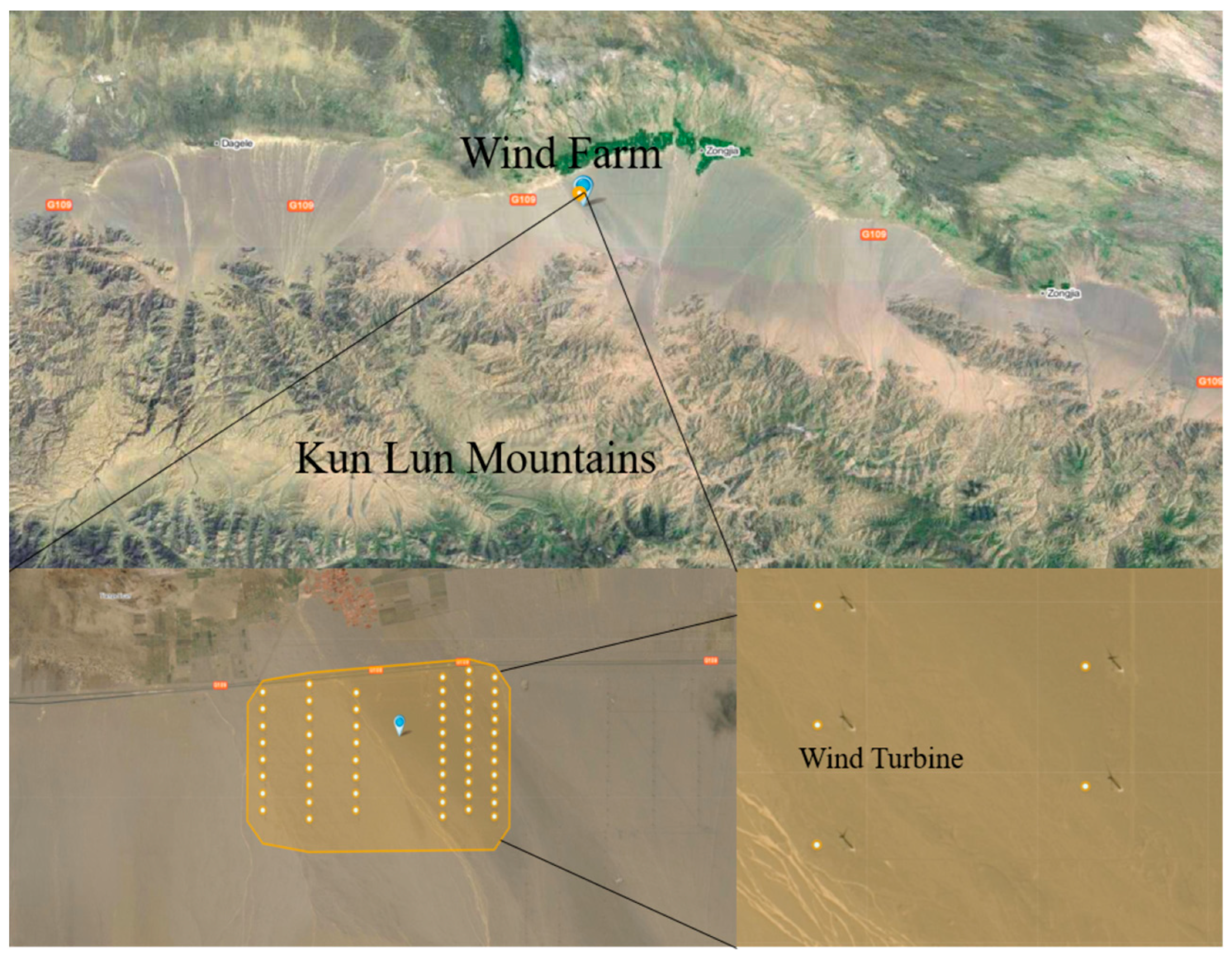

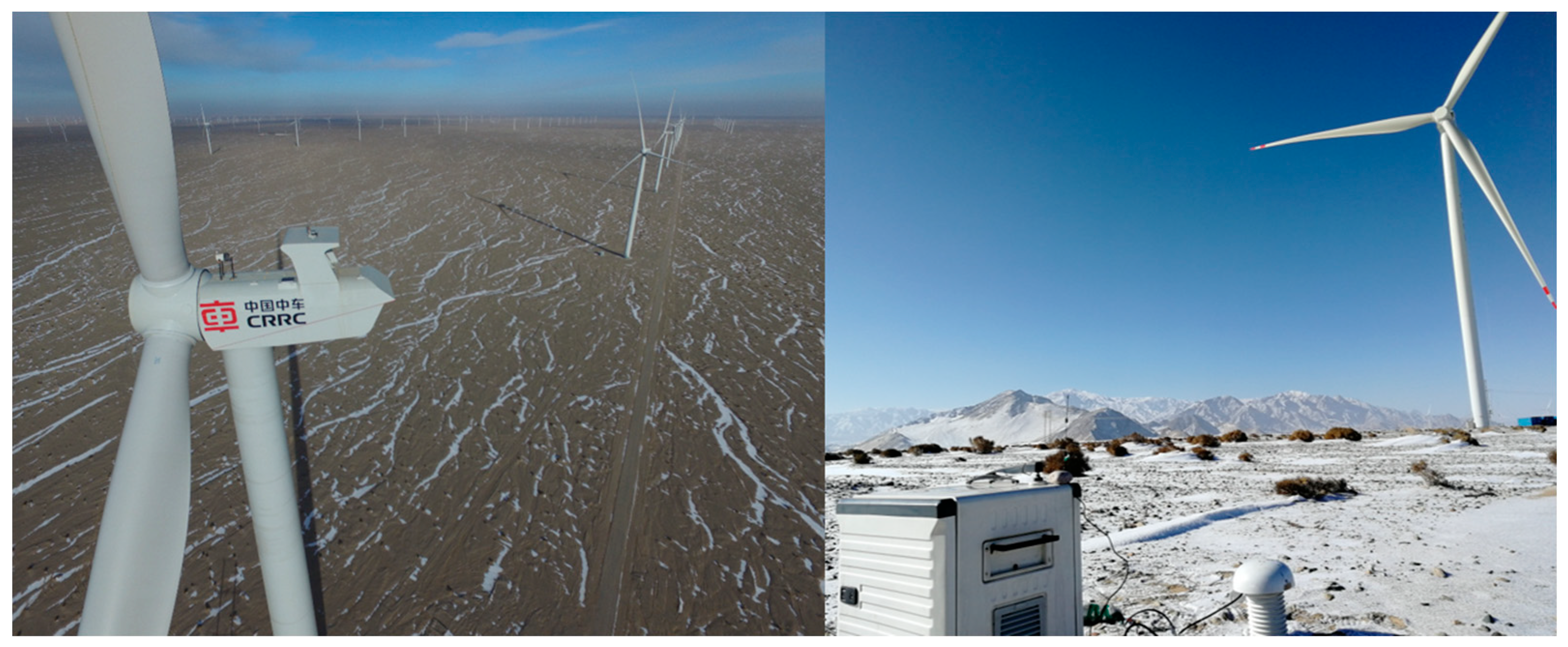
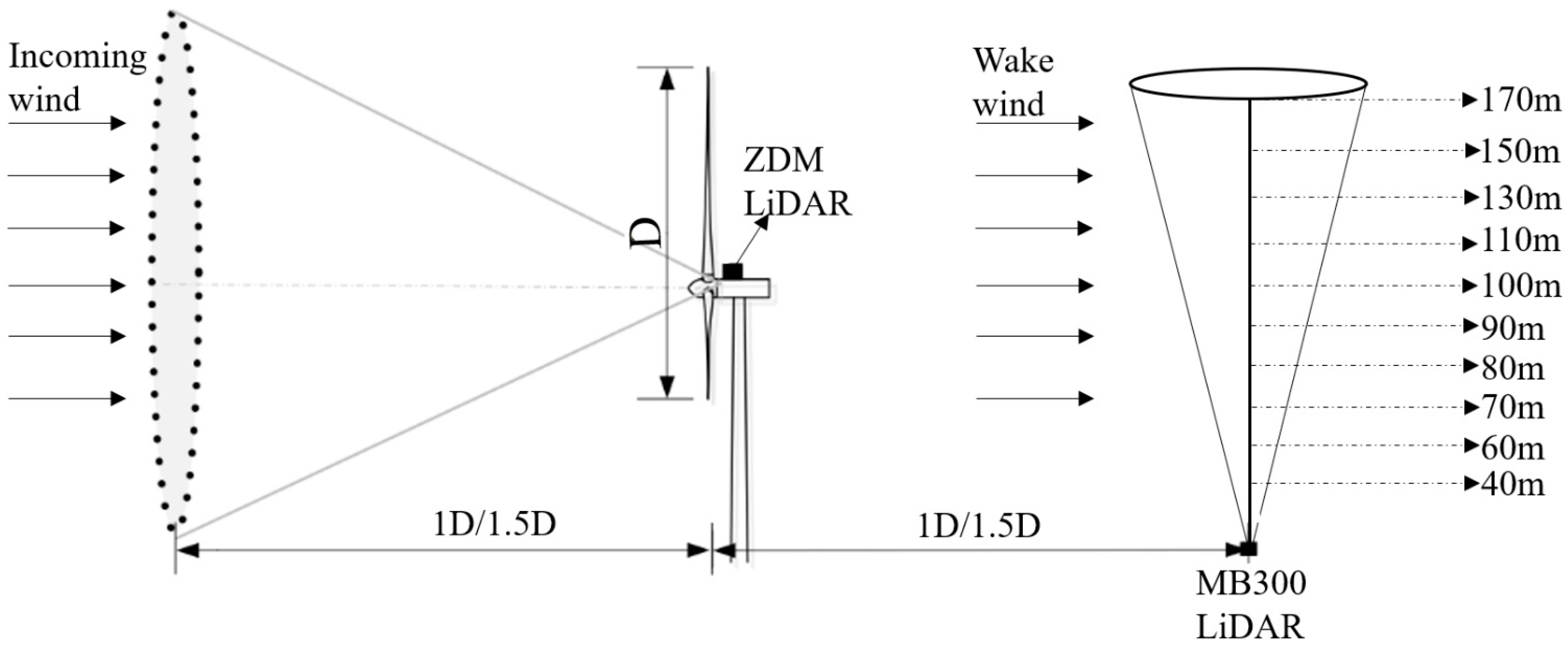
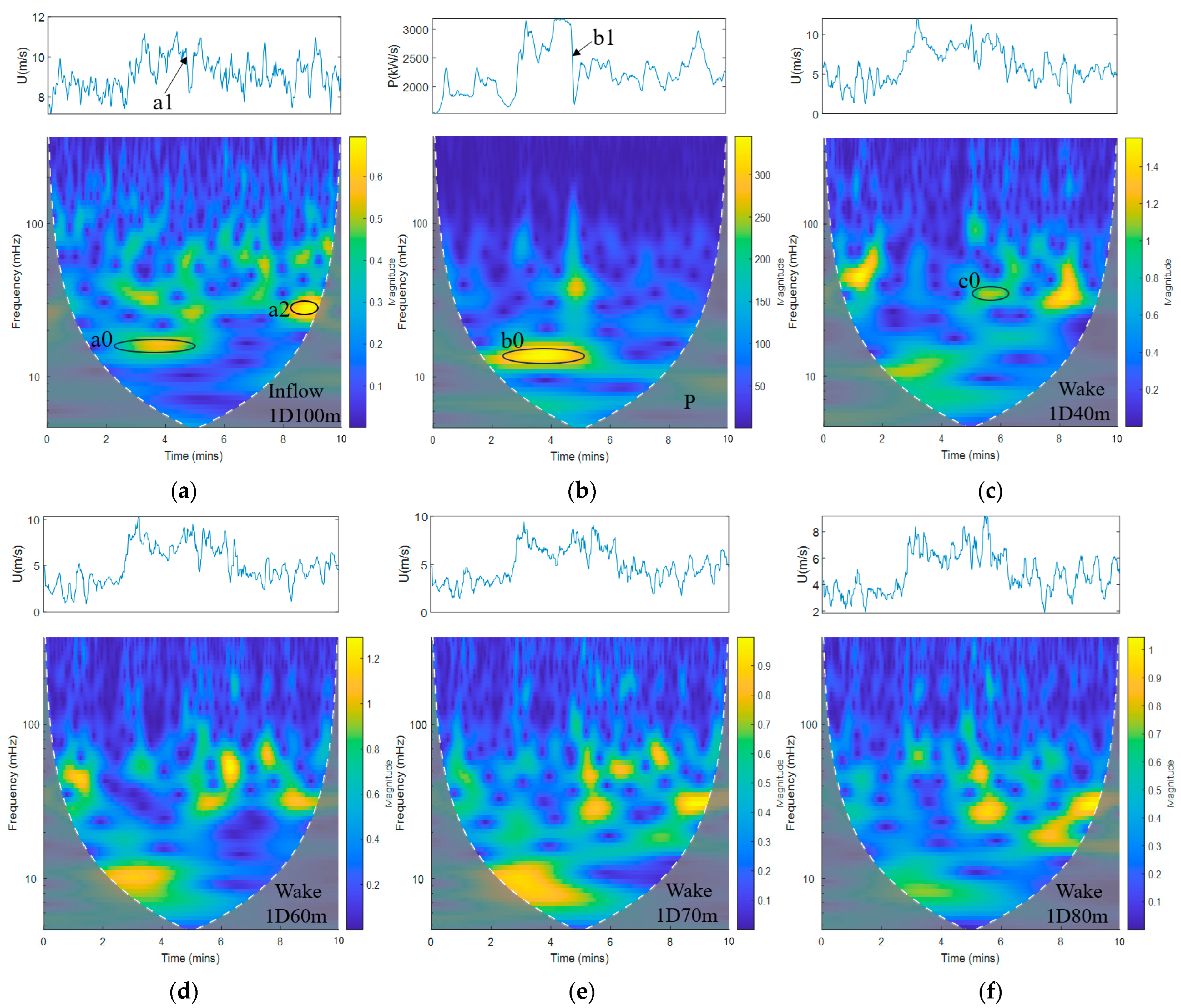

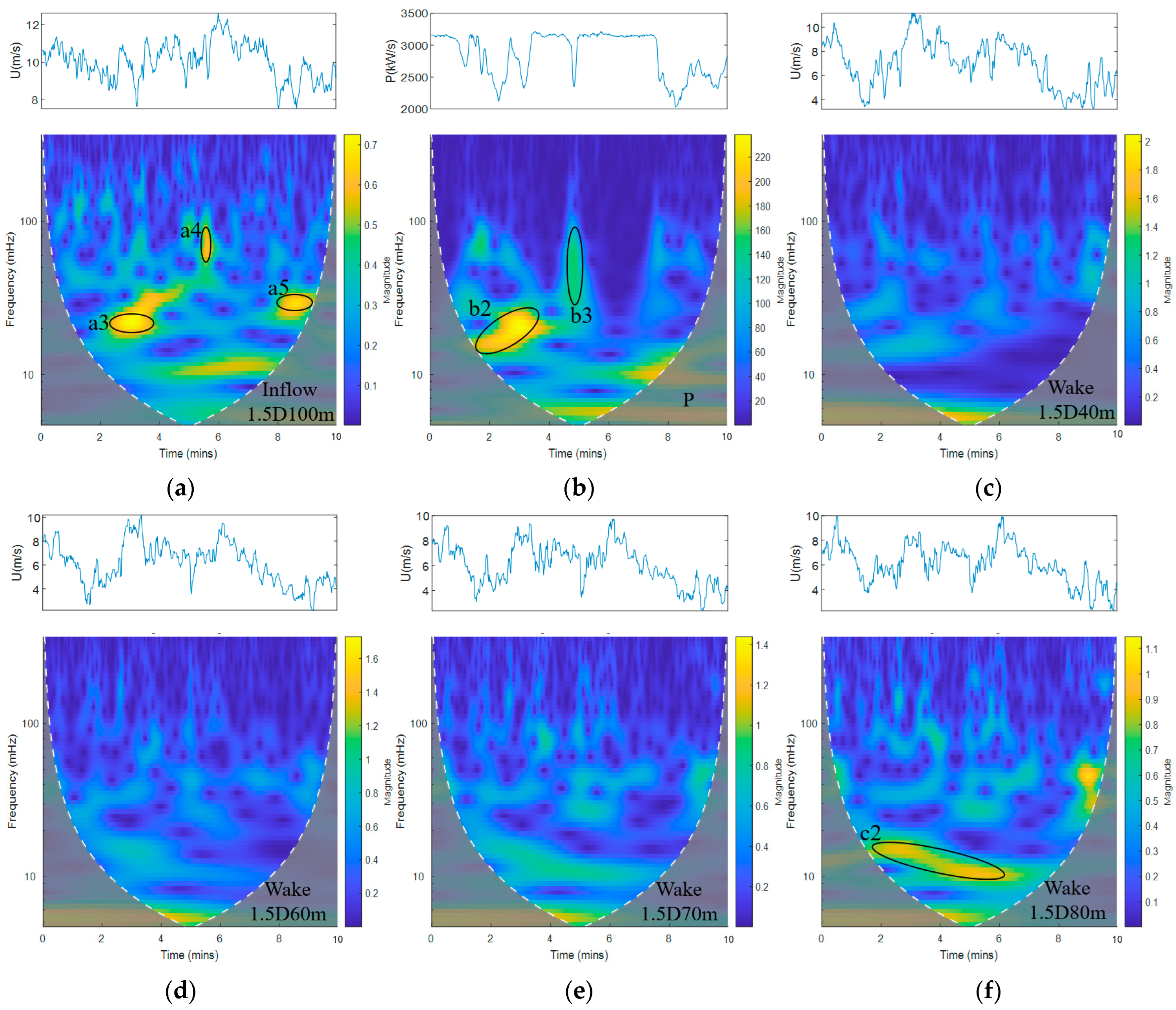
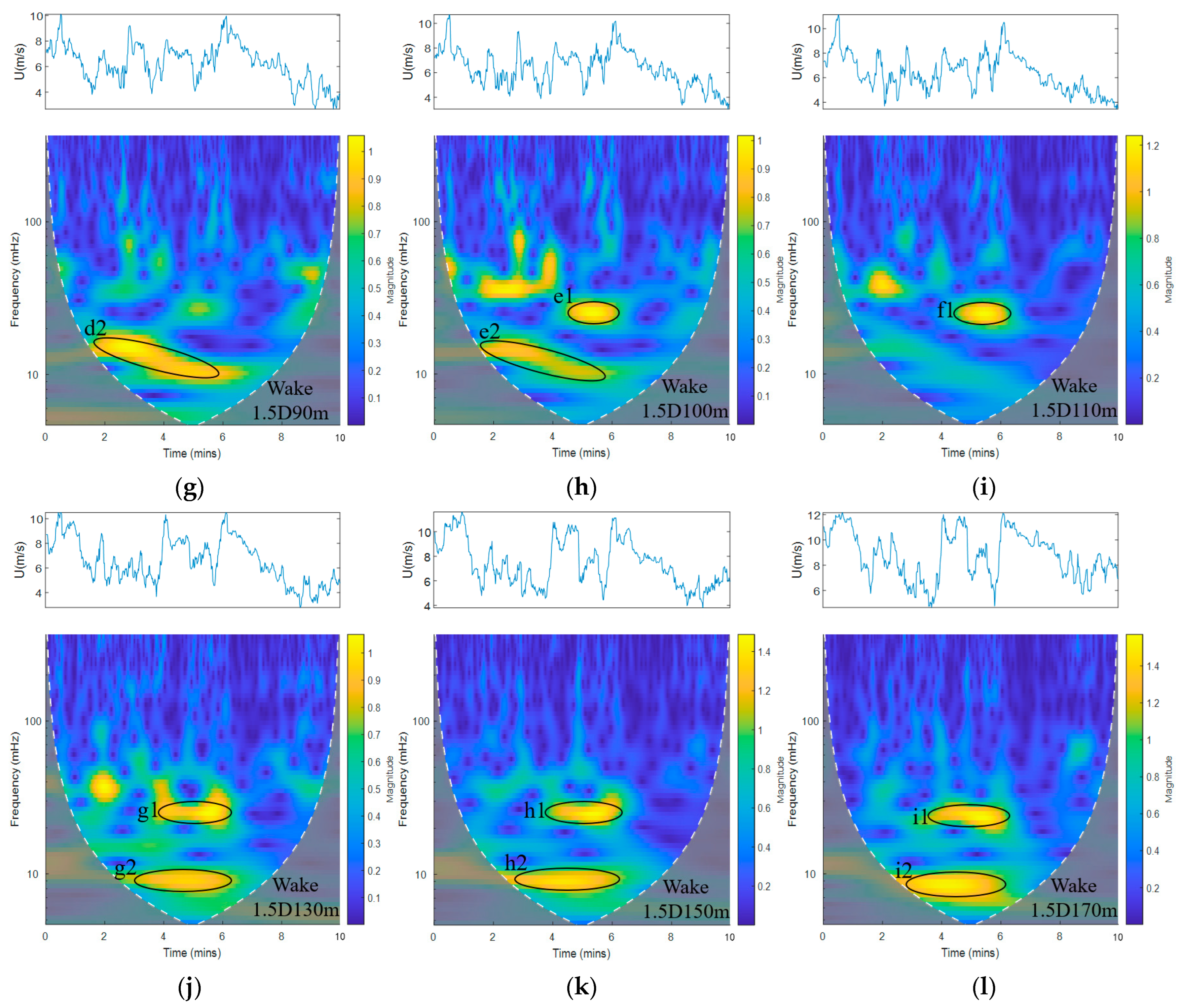
| ZDM LiDAR | MB300 LiDAR | ||
|---|---|---|---|
| Parameters | Description | Parameters | Description |
| Measure distance (m) | 10~300 | Measure distance (m) | 40~300 |
| Measuring the number of layers (C: Number of layers) | 10C | Measuring the number of layers (C: Number of layers) | 12C |
| sampling frequency (HZ) | 50 | sampling frequency (HZ) | 1 |
| Wind speed accuracy (m/s) | 0.1 | Wind speed accuracy (m/s) | 0.1 |
| Wind direction accuracy (°) | 0.5 | Wind direction accuracy (°) | 1 |
| Wind speed range (m/s) | 1~80 | Wind speed range (m/s) | 0~75 |
| Temperature range (°C) | −40~50 | Temperature range (°C) | −40~50 |
| Authentication | IEC61400-12-1:2017 [44] | Authentication | IEC61400-12-1:2017 |
| Incoming Wind Speed (m/s) | Temperature T (°C) | Pressure (mbar) | Wind Shear Index | Wind Deviation Error (°) | Upstream Location | Downstream Location | Output Power (kW) | Turbulence |
|---|---|---|---|---|---|---|---|---|
| 9.134 | −12.35 | 698 | 0.2091 | −1.83 | 1 D | 1 D | 1141.4 | 0.1 |
| 10.042 | −11.55 | 697 | 0.1158 | 0.126 | 1.5 D | 1.5 D | 2861.0 | 0.11 |
Disclaimer/Publisher’s Note: The statements, opinions and data contained in all publications are solely those of the individual author(s) and contributor(s) and not of MDPI and/or the editor(s). MDPI and/or the editor(s) disclaim responsibility for any injury to people or property resulting from any ideas, methods, instructions or products referred to in the content. |
© 2023 by the authors. Licensee MDPI, Basel, Switzerland. This article is an open access article distributed under the terms and conditions of the Creative Commons Attribution (CC BY) license (https://creativecommons.org/licenses/by/4.0/).
Share and Cite
Niu, H.; Yang, C.; Wang, Y. Experimental Study on the Influence of Incoming Flow on Wind Turbine Power and Wake Based on Wavelet Analysis. Energies 2023, 16, 6003. https://doi.org/10.3390/en16166003
Niu H, Yang C, Wang Y. Experimental Study on the Influence of Incoming Flow on Wind Turbine Power and Wake Based on Wavelet Analysis. Energies. 2023; 16(16):6003. https://doi.org/10.3390/en16166003
Chicago/Turabian StyleNiu, Hongtao, Congxin Yang, and Yin Wang. 2023. "Experimental Study on the Influence of Incoming Flow on Wind Turbine Power and Wake Based on Wavelet Analysis" Energies 16, no. 16: 6003. https://doi.org/10.3390/en16166003
APA StyleNiu, H., Yang, C., & Wang, Y. (2023). Experimental Study on the Influence of Incoming Flow on Wind Turbine Power and Wake Based on Wavelet Analysis. Energies, 16(16), 6003. https://doi.org/10.3390/en16166003





